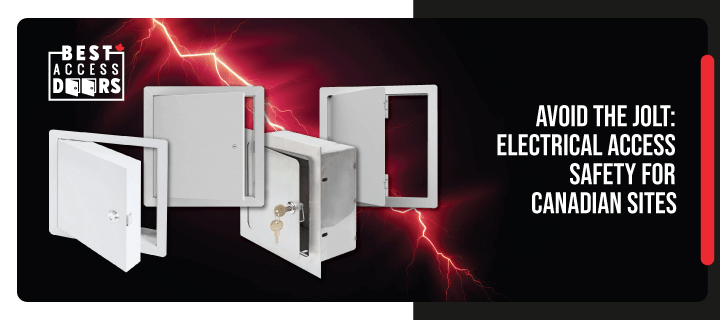What Are the Main Differences Between Prefabrication and Modular Construction? Posted by Best Access Doors Canada on 22nd May 2024
In today’s construction landscape, new methods like prefabrication and modular construction are changing the game. They speed up projects, improve quality, and cut down on waste. Bothmethods offer advantages over traditional construction, from cost to efficiency. But what sets them apart from each other?
In this article, we'll discuss the important differences between these two practices, helping you choose the best option for your project.
Prefabrication
Prefabrication is an innovative approach that streamlines construction.Various building components are manufactured and assembled in a controlled factory setting instead of being made on-site. These pre-made units are then transported to the actual location for assembly.
Prefabrication includes two main types of building:
- 2D Panel System
The 2D system builds internal and external walls, internal stairs, and building envelopes using panel and component systems. It offers a faster and more straightforward way to create and assemble customized designs than traditional methods.
- 3D Modular System
On the other hand, 3D modular systems are built off-site and delivered in boxes. These modules can be quickly stacked or connected, offering the fastest construction times but with limited design customization options.
Benefits of Prefabrication
- Enhanced Speed and Efficiency
Prefabrication significantly speeds up the construction timeline as factories make parts of the building while workers prepare the site. This parallel work saves time—essentially running two construction crews simultaneously.
When the parts are ready, workers bring them to the site and assemble them quickly. They're made in controlled conditions and fit perfectly, avoiding time-consuming adjustments.
- Superior Quality Control
Factory settings typically allow for stricter quality control measures compared to on-site construction. This translates to a more consistent and reliable building process, ensuring your project meets the highest quality standards.
- Reduced Environmental Impact
Prefabrication often leads to reduced construction waste. Additionally, the process can potentially minimize energy consumption, promoting an eco-conscious building approach.
Limitations of Prefabrication
- Limited Design Flexibility
Prefabrication often involves pre-designed components or modules that may not perfectly match your unique design vision. While some customization is possible, it might not be as extensive as you could achieve with traditional construction methods. It can be a drawback for highly customized or architecturally intricate projects.
- Transportation Challenges
Prefabricated components can be bulky and heavy, especially 3D modules. This can present logistical challenges and potentially increase costs, depending on the project's location and the size of the prefabricated units. Transporting the units to far locations can be expensive and require specialized equipment.
Modular Construction
Modular construction is a method where an entire building unit is constructed off-site rather than smaller structural components, as with prefabrication. The modular units require the least on-site construction time, as all plumbing, electrical, and even design finishes are installed in the facility.
Benefits of Modular Construction
- Fast Completion
As said, modular construction delivers the quickest construction timelines in the industry. With pre-built rooms arriving on-site, assembly is incredibly rapid, getting your project started much sooner.
- Greater Flexibility in Use
Modular buildings can be surprisingly versatile. They can be designed for various uses, such as residential homes, schools, offices, and even healthcare facilities. Modular buildings can also be reconfigured or even relocated if needed, offering flexibility for future changes.
- Increased Predictability
Modular construction offers greater predictability compared to traditional methods. With most elements prefabricated and controlled in factory environments, there must be more room for unexpected delays or cost overruns on-site.
Limitations of Modular Construction
- Limited Availability of Qualified Builders
While modular construction is gaining popularity, finding experienced builders specifically qualified in modular construction methods might be more challenging than traditional construction companies.
- Potential Lower Resale Value
The perception that modular construction needs to be more permanent than traditional buildings might affect resale value in some markets. While the reality is that modular buildings can be durable, some potential buyers might hold a different perception.
Incorporating BAC-EDG-GYP Flush Access Door
Whether you choose prefabrication or modular construction for your project, incorporating high-quality access doors is crucial. They provide essential entry points for maintenance, repairs, and inspections behind walls, ceilings, or floors.
One option to consider is our BAC-EDG-GYP flush access door. It features several functionalities that might be helpful for any project.
The access doorhas removable, concealed spring and pin-type hinges and a push-to-close latch, providing a discreet design. Once the corner bead is plastered, it becomes virtually invisible—seamlessly blending into its surroundings.
BAC-EDG-GYP door also has all-steel hardware and a concealed spring hinge for long-lasting performance.
To Sum Up
Prefabrication and modular construction are revolutionizing the building industry. These innovative approaches offer a faster, more efficient, and potentially more sustainable way to construct buildings.
At Best Access Doors Canada, we understand the evolving needs of modern construction. That's why we offer a range of access doors and panels designed to integrate with today's innovative building methods. Our products are built to adapt to the latest construction trends, ensuring functionality and aesthetics.
Wantto learn more? Planning to request a free quote? For more details about our access doors, call us at (800) 483-0823. Our dedicated team of product experts will guide you in finding the perfect access door solution.






